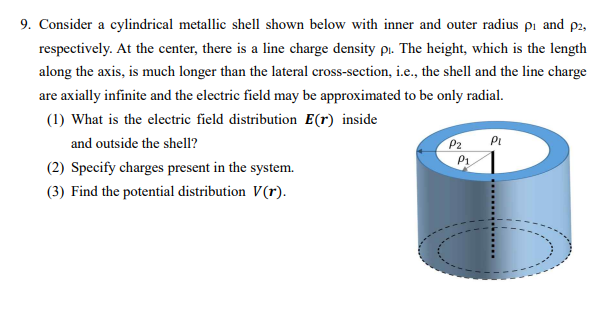9. Consider a cylindrical metallic shell shown below with inner and outer radius p₁ and p2, respectively. At the center, there is a line charge density pi. The height, which is the length along the axis, is much longer than the lateral cross-section, i.e., the shell and the line charge are axially infinite and the electric field may be approximated to be only radial. (1) What is the electric field distribution E(r) inside and outside the shell? (2) Specify charges present in the system. (3) Find the potential distribution V(r). P₂ P₁. PL D
9. Consider a cylindrical metallic shell shown below with inner and outer radius p₁ and p2, respectively. At the center, there is a line charge density pi. The height, which is the length along the axis, is much longer than the lateral cross-section, i.e., the shell and the line charge are axially infinite and the electric field may be approximated to be only radial. (1) What is the electric field distribution E(r) inside and outside the shell? (2) Specify charges present in the system. (3) Find the potential distribution V(r). P₂ P₁. PL D
Related questions
Question

Transcribed Image Text:9. Consider a cylindrical metallic shell shown below with inner and outer radius p₁ and p2,
respectively. At the center, there is a line charge density pi. The height, which is the length
along the axis, is much longer than the lateral cross-section, i.e., the shell and the line charge
are axially infinite and the electric field may be approximated to be only radial.
(1) What is the electric field distribution E(r) inside
and outside the shell?
(2) Specify charges present in the system.
(3) Find the potential distribution V(r).
P₂
P₁
PL
Expert Solution
This question has been solved!
Explore an expertly crafted, step-by-step solution for a thorough understanding of key concepts.
Step by step
Solved in 4 steps with 4 images
